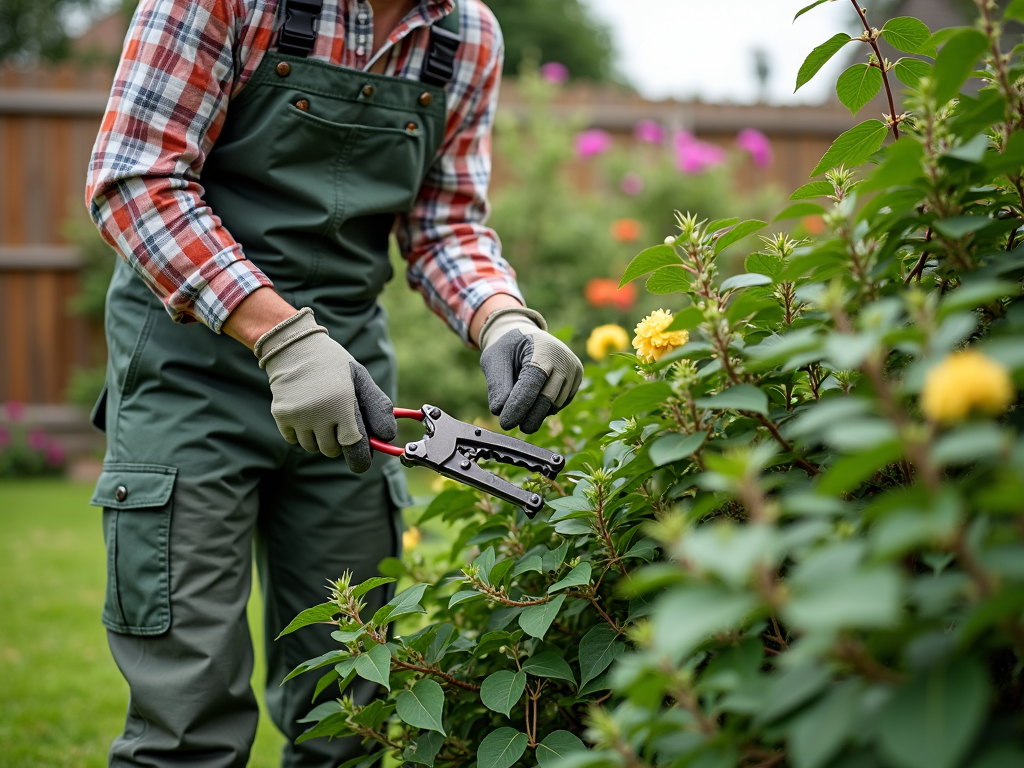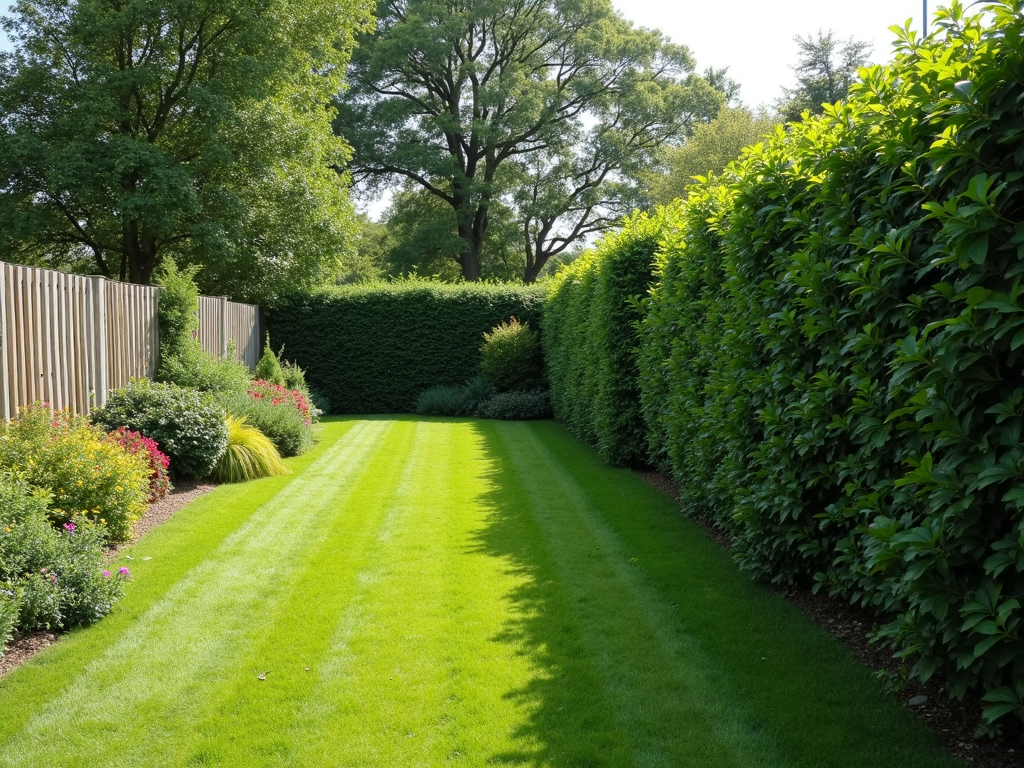
Overview
Introduction to Bush Trimming
Overgrown bushes can make a garden look neglected, but with the right approach, you can restore structure and beauty. Overgrown bushes are often found in the backyard or yard, where they can quickly become unruly if not maintained. In places like Shropshire, where seasonal growth can be especially vigorous, it’s easy for shrubs to get out of hand without regular care. Trimming not only looks good but also supports plant health by allowing better air circulation and light penetration. Whether you have fast-growing hedges or ornamental shrubs, regular maintenance, including pruning shrubs, is key to keeping everything under control.
Regular trimming keeps your landscape healthy and looking good. Large overgrown bushes often start as small shrubs that are not pruned regularly, leading to overgrowth. Deciduous and evergreen shrubs have different pruning needs, and understanding these differences will give you strong, healthy plants not damaged.
Pruning can be a powerful tool to manage unruly growth. In cases of extreme overgrowth, severe pruning may be needed. When done correctly, this can revitalise tired-looking shrubs and stimulate new growth, creating a healthier plant in the long term.
Knowing whether your shrubs are deciduous or evergreen is key before you make the first cut. Each type responds differently to pruning, so it’s important to adapt your approach accordingly. At Luxe Gardens, we’ve found that taking a tailored approach to each plant type makes a noticeable difference in both the health and overall look of a garden.
Identifying Shrub Types
Deciduous shrubs like forsythia and dogwood shed their leaves in the winter and need pruning regularly to encourage new growth in the spring. These types of plants should be cut back after they’ve finished flowering to keep them tidy and healthy year after year. Autumn is a good time for renovation pruning of certain deciduous shrubs, as it allows for recovery before spring growth.
Evergreen shrubs like yew and hollies keep their leaves all year round. While they need less pruning than deciduous varieties, they still need occasional shaping to prevent them from becoming too dense or woody over time. Evergreens have unique pruning needs, and regular maintenance helps keep them healthy and attractive throughout the year. In places like Shropshire, where gardens have a mix of plant types, knowing the seasonal needs of each shrub is key.
Proper identification of your shrubs is the first step in choosing the right pruning approach. Misidentifying a plant could mean incorrect timing or cutting and weakening the shrub, or reducing its bloom. When identifying dead wood, look for leafless branches that are brown and brittle, as these should be removed to promote healthy growth.
Some shrubs like azaleas and viburnums need more careful pruning. Pruning them at the wrong time can affect flowering and shape so it’s important to know their specific needs. Pruning at the wrong time can also reduce the number of flowers produced, as some shrubs set their flowers in the fall, and cutting them then can remove next season’s blooms. Homeowners who want a professional look often reference services like Luxe Gardens for guidance on how to manage these delicate species.
Ultimately, knowing how your shrubs grow – whether they bloom on old wood, new growth or grow in a spreading or upright way – will guide your pruning and keep them healthy and looking good for years to come. Removing older branches gradually over several years can also help rejuvenate overgrown shrubs and encourage vigorous new growth.
Pruning Overgrown Bushes
Pruning overgrown bushes is essential for restoring both the health and appearance of your landscape. The first step is to identify the type of shrub you’re working with—whether it’s an evergreen shrub, a deciduous shrub, or a specific species like azalea or viburnum. Each type responds differently to pruning, so understanding your plant’s needs is crucial for proper pruning.
For most overgrown bushes, renovation pruning or rejuvenation pruning is the best approach. Renovation pruning involves cutting back the shrub significantly, often removing one-third of the oldest stems right at ground level. This encourages vigorous new growth and helps the shrub regain its natural shape. It’s important to leave some of the remaining old stems intact to support the plant as it recovers and to avoid shocking the shrub.
The best time to prune overgrown bushes is typically in late winter or early spring, just before new growth begins. This timing allows the shrub to channel its energy into producing healthy new shoots as the weather warms. When pruning, always use clean, sharp tools and make your cuts at ground level for the oldest stems, taking care not to damage the base of the plant. Over the next few seasons, continue to remove one-third of the oldest stems each year until the shrub is fully rejuvenated.
By following these steps, you’ll help your overgrown bushes bounce back, promoting lush growth and a more attractive, natural shape in your garden.

Pruning Techniques
There are several ways to prune overgrown shrubs. Renovation and rejuvenation pruning are two ways to get neglected plants back in shape. Renovation pruning is selecting out old or unproductive branches, and rejuvenation pruning is cutting back over a few years. After being pruned, shrubs may look sparse at first, but they will recover with healthier, more vigorous growth.
Severe pruning – often called renewal pruning – is a more drastic method of cutting the shrub back to ground level. It may seem extreme, but it’s often necessary for older shrubs that have become woody and unproductive. Many gardens in Shropshire, especially older properties with mature plantings, need this kind of TLC.
Timing is everything when it comes to pruning. For most shrubs, early spring or late winter is the best time to prune. This controls excessive growth before the growing season kicks in and promotes healthy growth throughout the year. Some evergreens, such as yews, arborvitae, and hemlocks, can be pruned in early summer after new growth has started.
A common rule of thumb is to remove about a third of the oldest stems each year. This selective pruning allows air to circulate and light to get into the shrub, reducing the risk of disease and supporting regeneration. You should also thin out crowded branches to improve airflow and help shape the plant.
Depending on the shrub and how it grows, pruning schedules and methods will vary. When making cuts, it’s best to cut back to the main stem or a strong lateral branch for optimal regrowth. If you’re unsure when or how to prune, look at what the professionals do or consult with a local expert like Luxe Gardens to develop a plan for your garden.
Regular maintenance is key to keeping shrubs healthy and attractive. A regular trim helps maintain the desired shape and prevents the plant from becoming overgrown.
When shaping shrubs, pay attention to the canopy to ensure a balanced and attractive appearance.
Renovation Pruning
Renovation pruning is a bold but brilliant way to restore overgrown shrubs by cutting them back almost to the ground. This encourages new growth and helps the plant to get back to its natural shape. When done right, it can even revive the most neglected of shrubs.
This is generally recommended for deciduous shrubs, which respond well to hard pruning. But it’s not always suitable for evergreen shrubs, as the shock of such a drastic cut can sometimes damage them or result in uneven regrowth. Gardeners in areas like Shropshire, where both types of shrubs are common, need to assess the species before attempting this method.
Renovation pruning should be done in early spring or late winter before new growth begins. This gives the shrub a full growing season to recover and fill out. As a general rule, pruning just before the plant comes out of dormancy gives the best results.
Getting it right is key to avoiding long-term damage. Making clean angled cuts just above buds or nodes means the plant can direct its energy into new, healthy growth. If you’re not sure how to make these cuts, it may be worth watching how landscape professionals like Luxe Gardens approach similar projects.
After renovation pruning, monitor the recovery closely. Check the soil around the base of the shrub and improve it if needed, as healthy soil is essential for strong regrowth after such drastic pruning.
After renovation, pruning, it’s important to maintain a regular trimming schedule. Lighter pruning in the following seasons will help the shrub keep its shape, prevent future overgrowth, and support continued healthy growth. By the third year, most shrubs will have regained their shape and vigor if renovation pruning and ongoing maintenance have been done correctly.
Rejuvenation Pruning
Rejuvenation pruning is a gentle process of removing about a third of the oldest stems at the base of the shrub. This encourages new growth and keeps the plant healthy and not too woody or dense over time.
This method is especially good for deciduous shrubs, which respond well to steady incremental pruning. Doing this in early spring or late winter gives the plant time to recover and grow before the main growing season. In areas like Shropshire, where the weather can be quite extreme, getting the timing right makes all the difference in regrowth.
Rejuvenation pruning not only revives the health of the shrub but also helps to achieve a more natural shape. Done properly, this technique enhances the plant without the shock of severe cutting.
Precision is key – each cut should be made thoughtfully to not stress the plant. If you’re not sure of the proper pruning techniques, studying work done by experienced landscapers like those at Luxe Gardens or consulting a local expert can be helpful in developing your skills.
After the initial rejuvenation, it’s important to prune regularly. Ongoing maintenance keeps the shrub healthy, prevents future overgrowth and reduces the need for more drastic measures later on.
Preventing Overgrowth
Preventing overgrowth in your shrubs is all about regular pruning and attentive care. The key is to prune shrubs at the right time—early spring, late winter, or even summer, depending on the species. Evergreen shrubs, in particular, often benefit from more frequent pruning to maintain their shape and encourage healthy, vigorous growth.
One of the most effective ways to prevent overgrowth is by removing crossing branches and any dead wood. This not only keeps the shrub looking tidy but also allows more light and air to reach the inner branches, which helps stimulate new shoots. For certain shrubs, regular pruning is essential to maintain their natural shape and prevent them from becoming leggy or overgrown.
By making pruning a routine part of your garden maintenance, you’ll encourage strong, healthy growth and keep your shrubs looking their best year-round. Regular attention helps prevent the need for drastic renovation later and ensures your landscape remains vibrant and well-shaped.

DIY Pruning
DIY pruning is an option for smaller shrubs and bushes. With the right approach, it’s a quick and easy way to keep your garden tidy. But larger or more mature shrubs may require more complex techniques or professional guidance if structural reshaping or severe cuts are needed.
Having the right tools – sharp bypass pruners, loppers and pruning saws – can make all the difference to the ease and quality of your work. Just as important are the techniques used; knowing where and how to cut ensures the shrub heals properly and grows back stronger. In Shropshire, where growth can vary by season, knowing the right time and method for each plant is key.
Before you start, it’s essential to correctly identify your shrub and learn about its growth habits. Some shrubs flower on new wood, others on old; some grow upright, others spread. This will help you make informed decisions about when and how much to prune.
Regular pruning keeps your garden healthy and looking good over time. Neglected plants become tangled and weak, while regular attention means a more structured and vibrant landscape. Many gardeners in Shropshire take pride in their outdoor space by including pruning in their seasonal garden maintenance.
Pruning can be a satisfying and hands-on way to look after your garden, but it does carry risks if done wrong. If you’re unsure or dealing with valuable or tricky plants, it may help to watch the professionals in action, like those at Luxe Gardens, or consult someone with local horticultural knowledge.
Choosing the Right Tools
Using the right tools for pruning is just as important as knowing how and when to prune. The right equipment means clean cuts that support healthy regrowth and don’t damage the plant. Poor quality or wrong tools will tear stems or branches and make the shrub more prone to disease.
Hand pruning shears for smaller stems, loppers for thicker branches and pruning saws for larger woody growth are common pruning tools. Each tool has its place depending on the size and shape of the shrub. Shropshire gardens often have a mix of shrubs so you may need a combination of tools. For example, shrubs in Shropshire gardens often have a variety of species so you may need a mix of tools.
Knowing the specific growth habit and type of shrub you are working with helps you choose the right tool for the job. Delicate shrubs may need precision shears, and overgrown shrubs may need something more robust. Many professionals, including those at Luxe Gardens, use a range of high-quality tools to make accurate, healthy cuts.
Tool maintenance is another often overlooked aspect of pruning. Regular cleaning and sharpening of blades make pruning easier and extend the life of your tools. Well-maintained equipment also reduces strain on your hands and arms, especially for longer tasks.
And cleanliness is key – always use clean, sharp tools to avoid spreading plant diseases. Sanitise blades between plants to protect your whole garden and the long-term health of your shrubs.
Safety Precautions
When tackling overgrown bushes, safety should always come first. Before you start pruning, make sure to wear protective gear such as sturdy gloves and safety glasses to shield yourself from thorns, sharp branches, and flying debris. Always use sharp, clean pruning tools to make precise cuts and reduce the risk of spreading disease between plants.
Be mindful of your surroundings—avoid pruning near power lines, fences, or other hazards that could pose a risk to you or your property. It’s also important to prune in a way that maintains the structural integrity of the plant; avoid making cuts that could leave the bush unstable or prone to breakage, especially with larger, overgrown bushes.
By following these safety precautions, you can confidently prune your overgrown bushes, ensuring both your safety and the long-term health of your plants.
Landscaping Options
When faced with overgrown shrubs, you have several landscaping options to consider. For shrubs that are still healthy, you might choose to prune them back to ground level, removing all the old growth to encourage a flush of new shoots. This approach can be especially effective for certain species and is a form of renovation pruning.
Alternatively, you can opt for a more gradual method by removing one-third of the oldest stems each year over several years. This allows the shrub to recover slowly and maintain some structure while new growth develops. If a shrub is too far gone—perhaps diseased or no longer thriving—it may be best to replace it with a new plant that better suits your landscape’s needs.
Consulting with a professional landscaper can help you assess your options and create a tailored plan for your garden. Whether you choose renovation, gradual rejuvenation, or replacement, the right approach will help you restore your landscape and create a beautiful, healthy outdoor space.
Common Problems
Overgrowth and plant disease are two of the most frequent issues gardeners face with shrubs. Fortunately, regular pruning and general maintenance can go a long way in preventing these problems before they take hold. By staying on top of growth, you reduce overcrowding and improve airflow, which discourages pests and fungal infections.
Knowing your shrub type and understanding its growth habits are key to spotting issues early. For instance, some plants may naturally grow dense and compact, while others spread quickly. In places like Shropshire, where gardens often feature a mix of ornamental and native shrubs, this awareness is crucial for effective care.
Routine pruning helps to preserve your shrubs’ vigour and health. By removing dead, damaged, or overcrowded branches, you give the plant a better structure and reduce competition for nutrients. This kind of preventive care is often what distinguishes well-kept gardens from those that struggle over time.
Some shrubs—like azaleas and viburnums—are particularly susceptible to issues such as mildew, dieback, or insect infestations. These species often require more attentive pruning to maintain both their shape and resilience. Taking inspiration from gardens maintained by professionals, such as those designed by Luxe Gardens, can be useful in understanding what regular care looks like for these plants.
Effective pruning not only shapes your shrubs but also plays a vital role in disease prevention. Removing infected or weak branches stops the spread of pathogens and encourages strong, healthy new growth in the seasons that follow.
Conclusion
Pruning overgrown bushes and shrubs is a vital part of keeping your landscape healthy and attractive. By understanding the specific species you’re working with and applying proper pruning techniques, you can restore the natural shape of your shrubs and encourage robust new growth. Regular pruning and maintenance are key to preventing overgrowth and ensuring your garden remains vibrant year after year.
Always prioritise safety when pruning, and don’t hesitate to seek professional advice if you’re unsure about the best approach for your plants. With thoughtful planning and the right landscaping options, you can create a lush, thriving landscape that enhances your outdoor living space. By taking these steps, you’ll enjoy a beautiful garden filled with healthy, well-shaped shrubs that bring lasting beauty and enjoyment to your home.
Why Choose Luxe Gardens for Expert Pruning in Shropshire
At Luxe Gardens, we specialise in restoring structure and beauty to overgrown gardens across Shropshire. Our team understands the unique needs of local plant varieties and offers expert pruning services tailored to your shrubs—whether it’s gentle rejuvenation or full renovation pruning. We take pride in delivering reliable, high-quality results that leave your garden healthier, tidier, and more vibrant. If you’re unsure how to tackle an unruly bush or want a professional touch, get in touch with Luxe Gardens and let us bring your outdoor space back to life.
Need a Hand with Your Overgrown Shrubs?
At Luxe Gardens, we understand how quickly shrubs can get out of hand—especially with the changing seasons here in Shropshire. We’ve helped countless homeowners bring structure and balance back to their gardens through careful, expert pruning. Whether it’s a light trim or a full renovation, we tailor our approach to suit each plant and each garden. If you’re looking for reliable, professional help to revive your outdoor space, we’d love to lend a hand.

